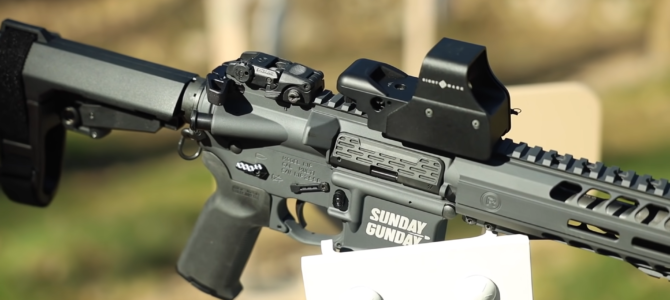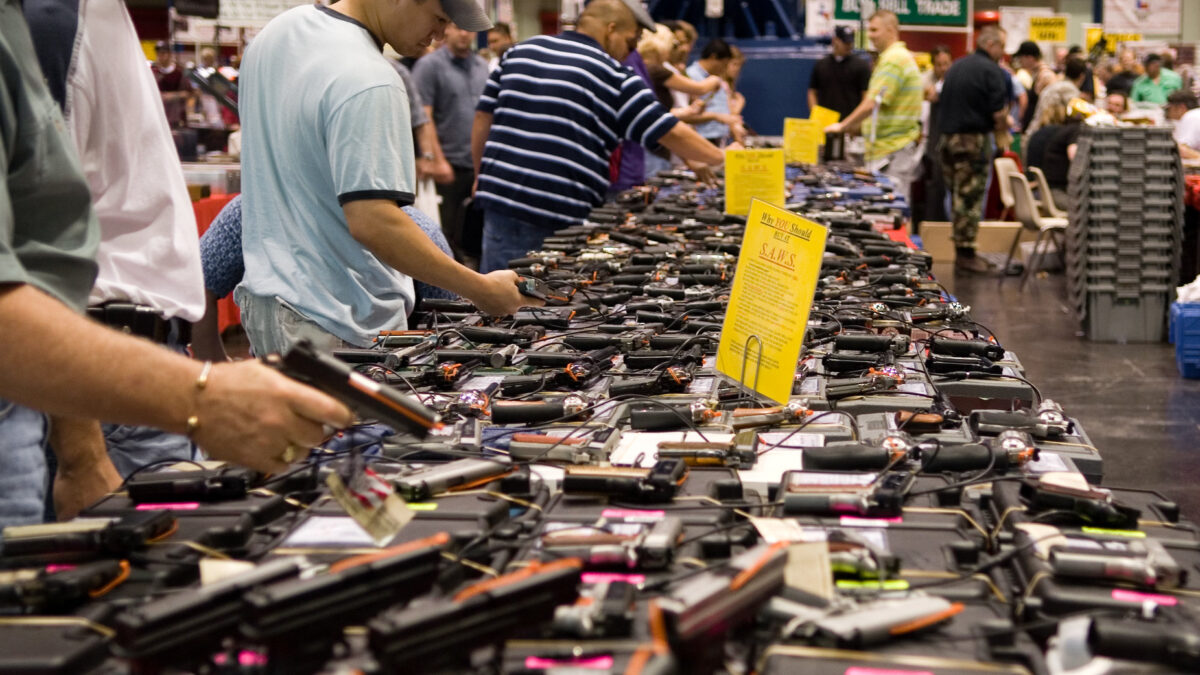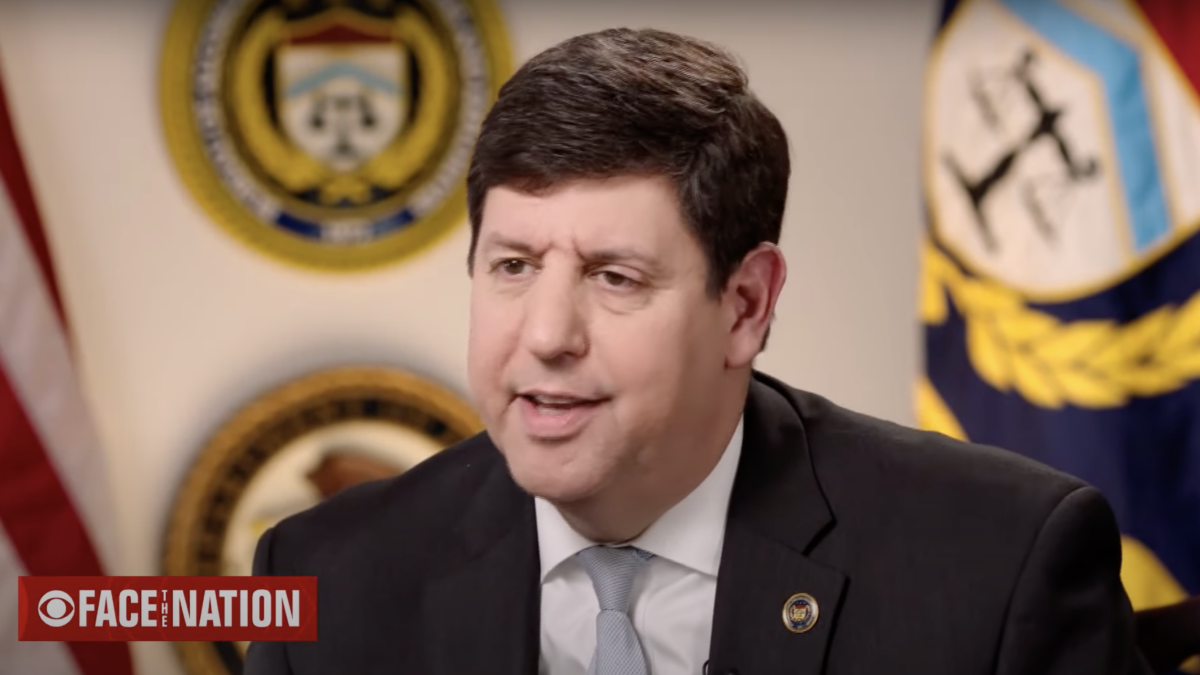
On June 10, the Department of Justice (DOJ) posted, in the Federal Register, a notice of proposed rulemaking and request for public comment, concerning firearms such as AR-15 pistols equipped with “stabilizing braces.” To bolster its position, the DOJ cited the Supreme Court’s decision in District of Columbia v. Heller (2008).
Before explaining how Heller comes to bear in this instance, some background is in order. Stabilizing braces were developed in 2013 to help wounded former military servicemen and other disabled Americans use, one-handed, AR-15s and similar firearms equipped with a barrel under 16 inches in length to reduce weight. But there’s a rub.
The National Firearms Act of 1934 (NFA) doesn’t define “pistol” or “handgun,” but it defines “rifle” as a firearm that, among other things, is “intended to be fired from the shoulder.” Furthermore, it requires federal registration and a $200 tax for any “rifle” less than 26 inches in overall length or having a barrel less than 16 inches in length, commonly referred to as a “short-barreled rifle” (SBR).
Because AR-15s and similar firearms are usually rifles, with shoulder stocks so they may be “fired from the shoulder,” the question has been whether such a firearm, having never been assembled as a rifle, but instead having been assembled from the outset as a pistol using a stabilizing brace instead of a stock, and a barrel shorter than 16 inches, would be considered a handgun or an SBR.
In 2014, the Bureau of Alcohol, Tobacco, Firearms and Explosives (BATFE) issued a letter to a manufacturer of stabilizing braces, stating, “[W]e have determined that firing a pistol from the shoulder would not cause the pistol to be reclassified as an SBR … Generally speaking, we do not classify weapons based on how an individual uses a weapon.”
In 2015, the agency issued a seemingly contradictory letter, stating that “the pistol stabilizing brace was neither ‘designed’ nor ‘intended’ to be used as a shoulder stock, and therefore use as a shoulder stock constitutes a ‘redesign’ of the device,” implying that a firearm so configured might be subject to the NFA. In 2017, the BATFE issued a private letter to a brace manufacturer saying the 2015 letter had been incorrect.
The BATFE Has Changed Its Mind … Again
After the BATFE’s 2014 letter, AR-15s and similar firearms assembled from the outset as handguns with stabilizing braces and short barrels became very popular and today number in the millions. Now the BATFE is reversing its reversal of its other reversal, to subject these firearms to the NFA.
The agency has done this sort of thing before. In 1989, it prohibited the importation of foreign-made rifles it had previously approved for importation. To justify that reversal, it reinterpreted 18 USC 925(d)(3), a provision of the Gun Control Act of 1968 (GCA), limiting the importation of firearms to those “generally recognized as particularly suitable for or readily adaptable to sporting purposes.”
The criterion was sports because Congress in 1968 was dominated by Democrats, the president was Democrat Lyndon B. Johnson, and then, as now, Democrats pretended that the Second Amendment doesn’t protect the right to keep and bear arms for defensive purposes.
The BATFE said that while “competitive target shooting is a recognized rifle sport,” it believed “‘sporting purpose’ should properly be given a narrow reading.” It thus ignored the most popular rifle sports at the time: Service Rifle, conducted under the auspices of the Director of Civilian Marksmanship, as provided for by federal law, and the Service Rifle component of NRA High Power, both culminating in the annual National Matches since 1903.
In 1993, the BATFE pulled another such stunt, which relates more closely to the present issue, and which I will describe in a moment. In 1994, the BATFE reinterpreted the NFA to prohibit several shotguns.
In 1998, the BATFE banned the importation of semi-automatic rifles made to comply with the 1989 ban, on the grounds that the rifles could use ammunition magazines banned in 1994 by Sen. Dianne Feinstein’s, D-Calif., 10-year “assault weapon” and “large” magazine ban, even though that law did not prohibit the tens of millions of such magazines Americans already owned. Furthermore, when Feinstein’s ban expired in 2004, the BATFE did not rescind its 1998 ban.
In 2015, after President Barack Obama failed to achieve a ban on AR-15s, the BATFE tried to ban, as “armor-piercing ammunition,” the second most commonly used AR-15 ammunition, called M855, which plainly does not meet the definition of such ammunition under 18 USC 921(a)(17)(B).
According to the proposed rule, the BATFE would use “Factoring Criteria for Rifled Barrel Weapons with Accessories commonly referred to as ‘Stabilizing Braces’” to determine whether such firearms are handguns or SBRs. Or would it?
After President Johnson signed the GCA into law, the BATFE developed factoring criteria for determining whether a handgun is eligible for importation, structured to deny the importation of the smallest handguns. However, in 1993, under orders from Democrat President Bill Clinton, who in the same timeframe signed into law Feinstein’s gun and magazine ban and legislation creating the firearm background check system, the agency ignored its handgun factoring criteria to ban the importation of large handguns that the BATFE had previously approved for importation.
DOJ Uses Heller To Promote Its Proposed Rule
Referring to the reason SBRs were included in the NFA, the DOJ says:
These weapons were viewed as especially dangerous and unusual, and, as a result, are subject to taxes and are required to be registered with ATF [BATFE]. The Supreme Court in District of Columbia v. Heller recognized these additional constraints as consistent with the Second Amendment. “We also recognize another important limitation on the right to keep and carry arms. [United States v.] Miller said, as we have explained, that the sorts of weapons protected were those ‘in common use at the time.’ We think that limitation is fairly supported by the historical tradition of prohibiting the carrying of ‘dangerous and unusual weapons.’”
Some people laud Heller because it recognized the “individual right to possess and carry weapons in case of confrontation,” including “all instruments that constitute bearable arms,” it pointed out that the Framers of the Bill of Rights considered “arms” to include all “weapons of offense and armour of defence,” and it struck down the District of Columbia’s bans on handguns and having any firearm in operable condition within the home.
Also, Heller so effectively explained why the right to arms is individually held that most Democrats in Congress, leftist anti-gun activist groups, and leftists in the media finally stopped claiming that the Second Amendment protects a “right” to possess a gun only while serving on-duty with a local or state militia, or the Militia of the United States, and (alternately and contradictorily) that it protects the “right” of a state to have a militia, an idea so ludicrous that even the four dissenting justices in Heller didn’t mention it. Of course, soldiers have no right to arms, they possess arms only if authorized by their commanders and, according to the Constitution, states don’t have “rights,” they have “powers.”
However, as explained here, Heller erred in at least two respects. First, it misinterpreted the Supreme Court’s decision in U.S. v. Miller (1939). Miller indicated that the right to keep and bear arms includes all arms that “have some reasonable relationship to the preservation or efficiency of a well-regulated militia,” such as those that are “part of the ordinary military equipment” and any others the use of which “could contribute to the common defense.”
Miller also noted that militiamen were historically “expected to appear bearing arms supplied by themselves and of the kind in common use at the time,” so Heller ignored the discussion of military and militia arms and instead concluded that Miller limited the right to arms to those “in common use.”
Also, Heller flat-out lied about so-called “dangerous and unusual weapons” laws, referred to by the DOJ. By way of background, the English Statute of Northampton (1328) prohibited people from carrying arms in affray of the peace, and in 1696 an English court interpreted that law to prohibit being armed, not in general, but for the purpose of terrorizing people. William Blackstone, in his famous 1769 Commentaries on the Laws of England, was first to use the phraseology “dangerous and unusual weapons” in this context, writing that the “[t]he offence of riding or going armed, with dangerous or unusual weapons, is a crime against the peace, by terrifying the good people of the land.”
As explained last week, automatic firearms were not at issue in Heller, but during oral arguments before the court, Solicitor General Paul Clement worried that declaring the right to arms to be individually held might call into question the constitutionality of the 1986 federal ban on the manufacture of automatic firearms, because an automatic, the M16 rifle from which the AR-15 is derived, “is the standard-issue armament for the National Guard.”
Although Clement didn’t spell it out, the problem, as he saw it, is that under 10 USC 246, the National Guard is the organized component of the Militia of the United States, and because the M16 is the most common arm among the militia’s organized component, it could be argued that it should not be banned from the militia’s unorganized component — all able-bodied males of ages 17-45 who are not in the organized component — nor from “the people” whose right to keep and bear arms the Second Amendment guarantees.
Thus, as the DOJ noted, Heller said that the 1986 ban on the manufacture of automatics for civilian use “is fairly supported by the historical tradition of prohibiting the carrying of ‘dangerous and unusual weapons.’” Contrary to the DOJ’s implication, however, Heller said nothing at all about SBRs.
The Judicial Solution
It’s not certain what a court faithful to the law can do to block the proposed rule on stabilizing braces, short of striking down the NFA on the grounds that its per-firearm $200 tax in 1934 (nearly $4,000 today) was intended to be prohibitive, thus is patently a violation of the right to keep and bear arms.
However, were the Supreme Court to take one or more cases challenging statewide “assault weapon” bans, it could jettison Heller’s “common use” standard on the grounds that it has no basis in the Second Amendment’s legislative history, is at odds with the amendment’s goal, and is based upon a mischaracterization of Miller and the antecedent to modern brandishing laws. It could also find that SBRs, commonly used for military purposes since at least the Vietnam War, are “ordinary military equipment” the use of which “could contribute to the common defense,” per Miller. Whether the present court has the courage to do so, only time will tell.









